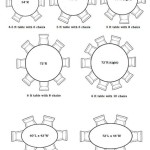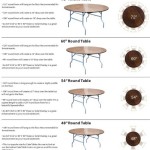The Enduring Importance of Table Setting
From the humblest family meal to the most extravagant banquet, the way a table is set holds profound significance. Beyond mere functionality, a thoughtfully arranged table communicates respect, elevates the dining experience, and fosters a sense of community. The practice of table setting transcends cultural boundaries and historical periods, consistently serving as a tangible expression of hospitality, refinement, and attention to detail.
The act of preparing a table for a meal is more than just placing utensils and dishes. It involves careful consideration of the occasion, the menu, and the guests who will be sharing the meal. The visual appeal of a well-set table stimulates the appetite and sets the stage for a positive and memorable dining experience. Furthermore, it demonstrates a conscious effort on the part of the host to create a welcoming and organized environment.
The significance of table setting can be examined from various perspectives, encompassing etiquette, aesthetics, and social dynamics. Understanding these facets allows for a deeper appreciation of the role table setting plays in shaping our interactions and enhancing our enjoyment of food.
Etiquette and Table Setting: A Foundation of Respect
Etiquette, in its broadest sense, represents a set of guidelines for social behavior. In the realm of dining, table setting plays a crucial role in conveying proper etiquette. The correct placement of utensils, glassware, and napkins demonstrates respect for established norms and provides diners with the tools necessary to navigate the meal with ease and confidence. This adherence to etiquette minimizes distractions and allows guests to focus on the food and the company.
For example, the placement of forks to the left of the plate and knives to the right is not arbitrary. It reflects the traditional sequence in which these utensils are used throughout a meal. Similarly, the arrangement of glasses in descending order of size, from water glass to wine glass, provides a visual cue for the appropriate beverage to accompany each course. These seemingly small details contribute significantly to a sense of order and predictability, which are hallmarks of good etiquette.
Beyond the functional aspects of utensil placement, table setting also conveys unspoken messages about the formality of the occasion. The use of fine china, silver cutlery, and crisp linen napkins signals a higher degree of formality than a casual setting with paper plates and plastic utensils. By carefully selecting the appropriate elements for the table setting, the host can effectively communicate the expectations for the event and guide guests in their behavior.
Moreover, proper table setting facilitates efficient service, particularly in formal dining settings. Servers can easily identify the purpose of each utensil and glass, ensuring that food and beverages are presented in the correct order and with minimal disruption. This streamlined service enhances the overall dining experience and contributes to a sense of professionalism and attention to detail.
Conversely, an improperly set table can be perceived as careless or even disrespectful. A missing utensil, a stained napkin, or a cluttered arrangement can detract from the meal and create a negative impression. By prioritizing proper table setting, individuals demonstrate their commitment to upholding standards of etiquette and creating a positive experience for their guests.
Aesthetics and Table Setting: Visual Appeal and Sensory Enhancement
The aesthetic dimension of table setting is equally important. A well-arranged table creates a visually appealing environment that enhances the dining experience by stimulating the senses and setting a positive mood. Color, texture, and composition all play a role in creating a harmonious and inviting atmosphere. The careful selection of tableware, linens, and decorative elements can transform a simple meal into a special occasion.
The choice of color palette is a key consideration in table setting aesthetics. Warm colors, such as reds and oranges, can create a sense of energy and excitement, while cool colors, such as blues and greens, can promote a feeling of calmness and relaxation. The use of contrasting colors can add visual interest and dynamism, while a monochromatic scheme can create a sense of elegance and sophistication. The chosen color palette should complement the food being served and the overall ambiance of the dining space.
Texture also plays a significant role in the visual appeal of a table setting. The interplay of smooth and rough surfaces, such as polished silverware and textured linens, can add depth and complexity to the arrangement. The use of natural materials, such as wood, stone, and flowers, can create a connection to the outdoors and enhance the sensory experience. The texture of the tableware itself, from the smooth surface of fine china to the rustic feel of earthenware, can also contribute to the overall aesthetic.
Composition, or the arrangement of elements on the table, is crucial for creating a balanced and visually pleasing effect. The placement of plates, utensils, and glasses should be carefully considered to ensure that the table is not too cluttered or too sparse. The use of centerpieces, such as floral arrangements or candles, can add a focal point and create a sense of visual harmony. The overall composition should be balanced and symmetrical, creating a sense of order and elegance.
Beyond the visual aspects, table setting also engages other senses. The aroma of fresh flowers, the soft glow of candlelight, and the feel of fine linens all contribute to the overall sensory experience. By carefully considering these sensory details, individuals can create a table setting that is not only visually appealing but also stimulating and enjoyable.
Social Dynamics and Table Setting: Fostering Connection and Communication
Beyond etiquette and aesthetics, table setting plays a significant role in shaping social dynamics and fostering connection among diners. A well-set table creates a welcoming and inviting atmosphere that encourages conversation and interaction. The act of sharing a meal around a thoughtfully arranged table promotes a sense of community and strengthens social bonds.
The physical arrangement of the table can influence the flow of conversation and the level of interaction among diners. A round table, for example, can promote a sense of equality and inclusivity, while a rectangular table may encourage more formal and hierarchical interactions. The placement of chairs and the spacing between diners can also affect the level of intimacy and communication. By carefully considering the layout of the table, hosts can create an environment that is conducive to meaningful conversation and connection.
Table setting can also serve as a visual cue for the type of interaction that is expected. A formal table setting, with its precise arrangement and elegant details, signals a more structured and restrained style of conversation. A casual table setting, with its relaxed atmosphere and informal elements, encourages a more relaxed and spontaneous style of interaction. By setting the table appropriately, hosts can effectively communicate the expectations for the event and guide guests in their behavior.
Furthermore, the act of preparing the table together can be a bonding experience in itself. Family members or friends who collaborate on setting the table are likely to engage in conversation and shared activities, strengthening their relationships and creating a sense of teamwork. This shared responsibility fosters a sense of ownership and pride in the dining experience.
In many cultures, the sharing of food is an integral part of social rituals and celebrations. Table setting plays a crucial role in these events, providing a visual representation of the importance of the occasion and the value placed on the guests who are gathered. By meticulously preparing the table, hosts demonstrate their respect and appreciation for their guests, creating a welcoming and memorable experience.
Ultimately, the importance of table setting lies in its ability to enhance the dining experience beyond the mere consumption of food. It represents a conscious effort to create a welcoming, organized, and aesthetically pleasing environment that fosters connection and communication. By understanding the principles of etiquette, aesthetics, and social dynamics that underlie table setting, individuals can elevate their dining experiences and create lasting memories with their guests.

Table Settings Etiquette And Inspiration For Entertaining

The Formal Place Setting Emily Post

Table Setting Diagrams Formal Fine Casual More Set Ups

Table Setting Diagrams Formal Fine Casual More Set Ups

Table Setting Diagrams Formal Fine Casual More Set Ups

Table Setting Diagrams Formal Fine Casual More Set Ups

Dining Etiquette Kent State University

How To Set A Table Guide Basic Casual Formal Setting

Table Settings Rules A Complete Guide Fine Dining

Table Setting Diagrams Formal Fine Casual More Set Ups
Related Posts








